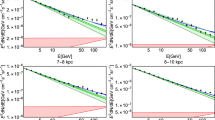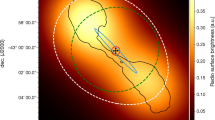Abstract
The Crab nebula is one of the most-studied cosmic particle accelerators, shining brightly across the entire electromagnetic spectrum up to very-high-energy gamma rays1,2. It is known from observations in the radio to gamma-ray part of the spectrum that the nebula is powered by a pulsar, which converts most of its rotational energy losses into a highly relativistic outflow. This outflow powers a pulsar wind nebula, a region of up to ten light-years across, filled with relativistic electrons and positrons. These particles emit synchrotron photons in the ambient magnetic field and produce very-high-energy gamma rays by Compton up-scattering of ambient low-energy photons. Although the synchrotron morphology of the nebula is well established, it has not been known from which region the very-high-energy gamma rays are emitted3,4,5,6,7,8. Here we report that the Crab nebula has an angular extension at gamma-ray energies of 52 arcseconds (assuming a Gaussian source width), much larger than at X-ray energies. This result closes a gap in the multi-wavelength coverage of the nebula, revealing the emission region of the highest-energy gamma rays. These gamma rays enable us to probe a previously inaccessible electron and positron energy range. We find that simulations of the electromagnetic emission reproduce our measurement, providing a non-trivial test of our understanding of particle acceleration in the Crab nebula.
This is a preview of subscription content, access via your institution
Access options
Access Nature and 54 other Nature Portfolio journals
Get Nature+, our best-value online-access subscription
$29.99 / 30 days
cancel any time
Subscribe to this journal
Receive 12 digital issues and online access to articles
$119.00 per year
only $9.92 per issue
Buy this article
- Purchase on Springer Link
- Instant access to full article PDF
Prices may be subject to local taxes which are calculated during checkout



Similar content being viewed by others
Data availability
The raw data and the code used in this study are not public but belong to the H.E.S.S. Collaboration. All derived higher-level data that are shown in plots will be made available on the H.E.S.S. Collaboration’s website (https://www.mpi-hd.mpg.de/hfm/HESS/pages/publications/pubs_jour.shtml) upon publication of this study.
References
Hester, J. J. The Crab nebula: an astrophysical chimera. Annu. Rev. Astron. Astrophys. 46, 127–155 (2008).
Bühler, R. & Blandford, R. The surprising Crab pulsar and its nebula: a review. Rep. Progr. Phys. 77, 066901 (2014).
Weekes, T. C. et al. Observation of TeV gamma rays from the Crab nebula using the atmospheric Cerenkov imaging technique. Astrophys. J. 342, 379–395 (1989).
Aharonian, F. A. et al. Optimizing the angular resolution of the HEGRA telescope system to study the emission region of VHE gamma rays in the Crab nebula. Astron. Astrophys. 361, 1073–1078 (2000).
Aharonian, F. A. et al. Observations of the Crab nebula with HESS. Astron. Astrophys. 457, 899–915 (2006).
Albert, J. et al. VHE γ-ray observation of the Crab nebula and its pulsar with the MAGIC telescope. Astrophys. J. 674, 1037–1055 (2008).
Meagher, K. Six years of VERITAS observations of the Crab nebula. Proc. Sci. Int. Cosmic Ray Conf. 236, 792 (2016).
Abeysekara, A. U. et al. Observation of the Crab nebula with the HAWC gamma-ray observatory. Astrophys. J. 843, 39 (2017).
Abdo, A. A. et al. Fermi Large Area Telescope observations of the Crab pulsar and nebula. Astrophys. J. 708, 1254–1267 (2010).
H.E.S.S. Collaboration et al. H.E.S.S. observations of the Crab during its March 2013 GeV gamma-ray flare. Astron. Astrophys. 562, L4 (2014).
Aleksić, J. et al. Measurement of the Crab nebula spectrum over three decades in energy with the MAGIC telescopes. J. High. Energy Astrophys. 5, 30–38 (2015).
Archambault, S. et al. Gamma-ray observations under bright moonlight with VERITAS. Astropart. Phys. 91, 34–43 (2017).
Weisskopf, M. C. et al. Discovery of spatial and spectral structure in the X-ray emission from the Crab nebula. Astrophys. J. 536, L81–L84 (2000).
Bogovalov, S. V. & Khangoulian, D. V. On the origin of the torus and jet-like structures in the centre of the Crab nebula. Mon. Not. R. Astron. Soc. 336, L53–L55 (2002).
Kennel, C. F. & Coroniti, F. V. Confinement of the Crab pulsar’s wind by its supernova remnant. Astrophys. J. 283, 694–709 (1984).
Kennel, C. F. & Coroniti, F. V. Magnetohydrodynamic model of Crab nebula radiation. Astrophys. J. 283, 710–730 (1984).
Atoyan, A. M. & Aharonian, F. A. On the mechanisms of gamma radiation in the Crab nebula. Mon. Not. R. Astron. Soc. 278, 525–541 (1996).
Madsen, K. K. et al. Broadband X-ray imaging and spectroscopy of the Crab nebula and pulsar with NuSTAR. Astrophys. J. 801, 66 (2015).
Ackermann, M. et al. The search for spatial extension in high-latitude sources detected by the Fermi Large Area Telescope. Astrophys. J. 237, 32 (2018).
Weisskopf, M. C., Elsner, R. F., Kolodziejczak, J. J., O’Dell, S. L. & Tennant, A. F. Unraveling the geometry of the Crab nebula’s ‘inner ring’. Astrophys. J. 746, 41 (2012).
Meyer, M., Horns, D. & Zechlin, H.-S. The Crab nebula as a standard candle in very high-energy astrophysics. Astron. Astrophys. 523, A2 (2010).
Del Zanna, L., Amato, E. & Bucciantini, N. Axially symmetric relativistic MHD simulations of pulsar wind nebulae in supernova remnants. On the origin of torus and jet-like features. Astron. Astrophys. 421, 1063–1073 (2004).
Komissarov, S. S. & Lyubarsky, Y. E. Synchrotron nebulae created by anisotropic magnetized pulsar winds. Mon. Not. R. Astron. Soc. 349, 779–792 (2004).
Bucciantini, N., Thompson, T. A., Arons, J., Quataert, E. & Del Zanna, L. Relativistic magnetohydrodynamics winds from rotating neutron stars. Mon. Not. R. Astron. Soc. 368, 1717–1734 (2006).
Del Zanna, L., Volpi, D., Amato, E. & Bucciantini, N. Simulated synchrotron emission from pulsar wind nebulae. Astron. Astrophys. 453, 621–633 (2006).
Volpi, D., Del Zanna, L., Amato, E. & Bucciantini, N. Non-thermal emission from relativistic MHD simulations of pulsar wind nebulae: from synchrotron to inverse Compton. Astron. Astrophys. 485, 337–349 (2008).
Porth, O., Komissarov, S. S. & Keppens, R. Solution to the sigma problem of pulsar wind nebulae. Mon. Not. R. Astron. Soc. 431, L48–L52 (2013).
de Naurois, M. & Rolland, L. A high performance likelihood reconstruction of γ-rays for imaging atmospheric Cherenkov telescopes. Astropart. Phys. 32, 231–252 (2009).
Li, T.-P. & Ma, Y.-Q. Analysis methods for results in gamma-ray astronomy. Astrophys. J. 272, 317–324 (1983).
Berge, D., Funk, S. & Hinton, J. Background modelling in very-high-energy γ-ray astronomy. Astron. Astrophys. 466, 1219–1229 (2007).
Gillessen, S. Sub-Bogenminuten-genaue Positionen von TeV-Quellen mit H.E.S.S. PhD thesis, Heidelberg Univ. (2004); https://archiv.ub.uni-heidelberg.de/volltextserver/4754/
Holler, M., Chevalier, J., Lenain, J.-P., de Naurois, M. & Sanchez, D. Run-wise simulations for imaging atmospheric cherenkov telescope arrays. Proc. Sci. Int. Cosmic Ray Conf. 301, 755 (2018).
Freeman, P., Doe, S. & Siemiginowska, A. Sherpa: a mission-independent data analysis application. Proc. SPIE 4477, 76–87 (2001).
Parsons, R. D. & Hinton, J. A. A Monte Carlo template based analysis for air-Cherenkov arrays. Astropart. Phys. 56, 26–34 (2014).
Dubner, G. et al. Morphological properties of the Crab nebula: a detailed multiwavelength study based on new VLA, HST, Chandra, and XMM-Newton images. Astrophys. J. 840, 82 (2017).
Macías-Pérez, J. F., Mayet, F., Aumont, J. & Désert, F.-X. Global spectral energy distribution of the Crab nebula in the prospect of the Planck satellite polarization calibration. Astrophys. J. 711, 417–423 (2010).
Mezger, P. G., Tuffs, R. J., Chini, R., Kreysa, E. & Gemuend, H.-P. Maps of Cassiopeia A and the Crab nebula at lambda 1.2 MM. Astron. Astrophys. 167, 145–150 (1986).
Bandiera, R., Neri, R. & Cesaroni, R. The Crab nebula at 1.3 mm. Evidence for a new synchrotron component. Astron. Astrophys. 386, 1044–1054 (2002).
Veron-Cetty, M. P. & Woltjer, L. Spectrophotometry of the continuum in the Crab nebula. Astron. Astrophys. 270, 370–378 (1993).
Hennessy, G. S. et al. Ultraviolet imaging telescope observations of the Crab nebula. Astrophys. J. 395, L13–L16 (1992).
Wu, C.-C. Interstellar extinction and ultraviolet flux distribution of the Crab nebula. Astrophys. J. 245, 581–588 (1981).
Kirsch, M. G. et al. Crab: the standard X-ray candle with all (modern) X-ray satellites. Proc. SPIE 5898, 22–33 (2005).
Jourdain, E. & Roques, J. P. The high-energy emission of the Crab nebula from 20 keV to 6 MeV with integral SPI. Astrophys. J. 704, 17–24 (2009).
Buehler, R. et al. Gamma-ray activity in the Crab nebula: the exceptional flare of 2011 April. Astrophys. J. 749, 26 (2012).
Aharonian, F. et al. The Crab nebula and pulsar between 500 GeV and 80 TeV: observations with the HEGRA stereoscopic air Cerenkov telescopes. Astrophys. J. 614, 897–913 (2004).
Acknowledgements
The support of the Namibian authorities and of the University of Namibia in facilitating the construction and operation of H.E.S.S. is gratefully acknowledged, as is the support by the German Ministry for Education and Research (BMBF), the Max Planck Society, the German Research Foundation (DFG), the Helmholtz Association, the Alexander von Humboldt Foundation, the French Ministry of Higher Education, Research and Innovation, the Centre National de la Recherche Scientifique (CNRS/IN2P3 and CNRS/INSU), the Commissariat à l’énergie atomique et aux énergies alternatives (CEA), the UK Science and Technology Facilities Council (STFC), the Knut and Alice Wallenberg Foundation, the National Science Centre, Poland (grant number 2016/22/M/ST9/00382), the South African Department of Science and Technology and the National Research Foundation, the University of Namibia, the National Commission on Research, Science and Technology of Namibia (NCRST), the Austrian Federal Ministry of Education, Science and Research and the Austrian Science Fund (FWF), the Australian Research Council (ARC), the Japan Society for the Promotion of Science and the University of Amsterdam. We appreciate the excellent work of the technical support staff in Berlin, Zeuthen, Heidelberg, Palaiseau, Paris, Saclay, Tübingen and Namibia in the construction and operation of the equipment. This work benefited from services provided by the H.E.S.S. Virtual Organisation, supported by the national resource providers of the EGI Federation. R.C.G.C. was funded by EU FP7 Marie Curie (grant agreement number PIEF-GA-2012-332350).
Author information
Authors and Affiliations
Consortia
Contributions
D.B., J.H., M. Holler, D.K. and R.D.P. analysed and interpreted the data, and prepared the manuscript. The whole of the H.E.S.S. collaboration contributed to the publication with involvement at various stages ranging from the design, construction and operation of the instrument, to the development and maintenance of all software for data handling, data reduction and data analysis. All authors reviewed, discussed, and commented on the present results and on the manuscript.
Ethics declarations
Competing interests
The authors declare no competing interests.
Additional information
Publisher’s note Springer Nature remains neutral with regard to jurisdictional claims in published maps and institutional affiliations.
Supplementary information
Supplementary Information
Supplementary Figures 1-2, Supplementary Tables 1-2, Supplementary References 1-13
Rights and permissions
About this article
Cite this article
H.E.S.S. Collaboration. Resolving the Crab pulsar wind nebula at teraelectronvolt energies. Nat Astron 4, 167–173 (2020). https://doi.org/10.1038/s41550-019-0910-0
Received:
Accepted:
Published:
Issue Date:
DOI: https://doi.org/10.1038/s41550-019-0910-0
This article is cited by
-
An extended Crab at TeV energies
Nature Astronomy (2019)



